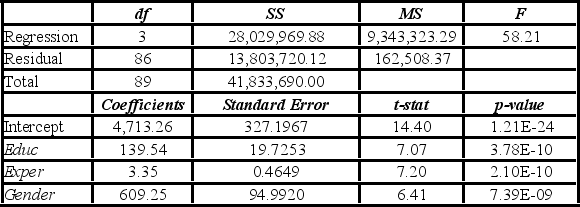Multiple Choice
To examine the differences between salaries of male and female middle managers of a large bank, 90 individuals were randomly selected, and two models were created with the following variables considered: Salary = the monthly salary (excluding fringe benefits and bonuses) ,
Educ = the number of years of education,
Exper = the number of months of experience,
Train = the number of weeks of training,
Gender = the gender of an individual; 1 for males, and 0 for females.
Excel partial outputs corresponding to these models are available and shown below.
Model A: Salary = β0 + β1Educ + β2Exper + β3Train + β4Gender + ε  Model B: Salary = β0 + β1Educ + β2Exper + β3Gender + ε
Model B: Salary = β0 + β1Educ + β2Exper + β3Gender + ε  Assuming the same years of education and months of experience, what is the null hypothesis for testing whether the mean salary of males is greater than the mean salary of females using Model B?
Assuming the same years of education and months of experience, what is the null hypothesis for testing whether the mean salary of males is greater than the mean salary of females using Model B?
A) H0: β3 ≤ 0
B) H0: β3 ≥ 0
C) H0: β3> 0
D) H0: β3 = 0
Correct Answer:

Verified
Correct Answer:
Verified
Q84: To avoid the dummy variable _, the
Q85: To examine the differences between salaries of
Q86: A realtor wants to predict and compare
Q87: For the linear probability model y =
Q88: In the model y = β<sub>0</sub> +
Q90: A medical researcher is interested in assessing
Q91: Which of the following represents a logit
Q92: To encourage performance, loyalty, and continuing education,
Q93: A dummy variable is a variable that
Q94: A realtor wants to predict and compare